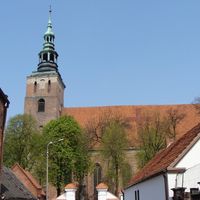Śrem
7.48

Overview
Śrem, located in Greater Poland, is one of the oldest towns in Poland, with a history dating back to the 11th century. In 1235, the stronghold was associated with Prince Władysław Odonic. The town was granted municipal rights in 1253, making Śrem one of the earliest urban settlements in the region. The town experienced various fortunes, from dynamic development in the Middle Ages, through difficult times of epidemics and invasions, to the period of partitions when Śrem fell under Prussian rule. During World War II, most of the Polish population was displaced, and after the war, economic revival began with the establishment of new industrial plants, including the Iron Foundry, which became the largest employer in the region.
Śrem's architecture surprises with its wealth of monuments, such as the 19th-century town hall in the Neoclassical style, the Church of the Assumption of the Blessed Virgin Mary with its Late Gothic tower, and the former Franciscan monastery complex, which is an example of Baroque architecture. Other interesting sites include the early 20th-century water tower and the restored market square, which retains its historical urban layout. Also worth noting are the numerous natural monuments and parks, such as the Park of the Greater Poland Insurgents, where you can admire historic trees.
Śrem is also a cultural center, hosting numerous events such as the Days of Śrem, religious song festivals, and patriotic celebrations. The Śrem Museum and the Śrem Cultural Center are important venues for local traditions and arts. The town cooperates with international partners, fostering cultural exchange. Śrem is home to many educational institutions, and its residents include well-known figures from the worlds of culture and science. The town also boasts a rich social life and numerous associations that engage citizens in activities for the local community.
In 2000, Śrem was awarded the title of the most ecological municipality in Poland in the urban-rural category. This town, with its rich history, interesting architecture, and strong cultural traditions, is an important point on the map of Greater Poland.
Location
You can also find here:
2025 Wizytor | All Rights Reserved

